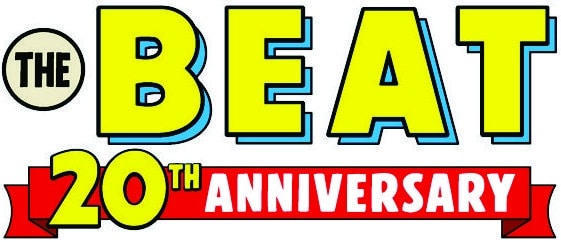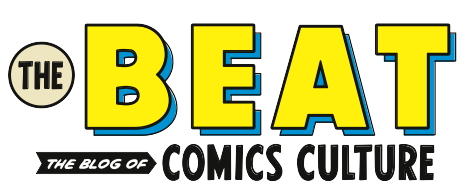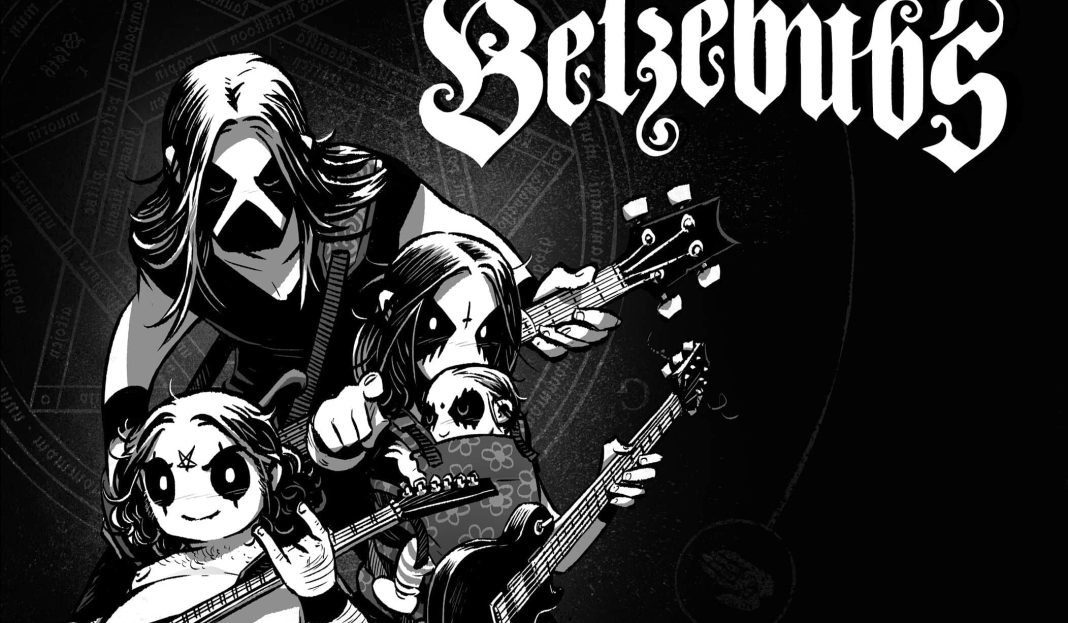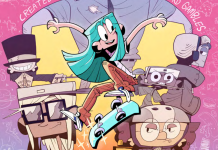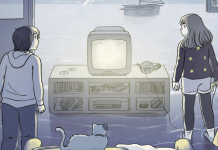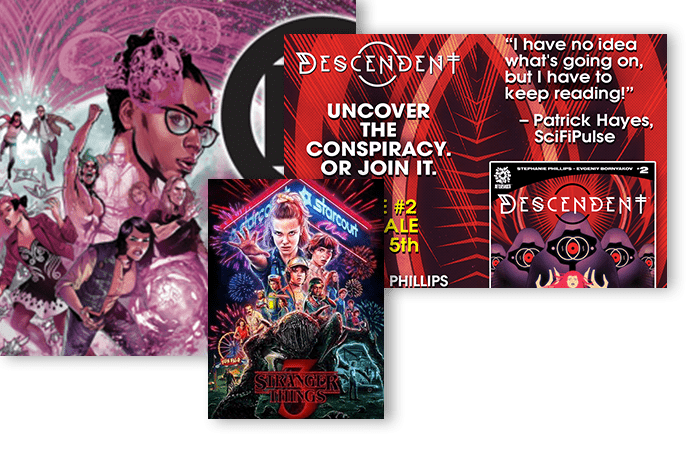Belzebubs is quite possibly the best comic strip you’ve never heard of. It’s ridiculously funny, heartfelt, and is a melting pot of some of the coolest things in life: monsters, metal, and a healthy family dynamic. Currently collected into two wonderful hardcovers by Top Shelf Productions, it’s well worth the investment, and there’s plenty more including merch, an album, a 360 experience, and an upcoming animated series.
The story follows a family of satanist black metal enjoyers in their oddly normal, yet often ridiculous daily lives. The Beat reached out to cartoonist JP Ahonen about Belzebubs, which you can read below.
This interview has been shortened and edited for clarity.
JARED BIRD: Hello and thank you so much for your time. In case anyone reading is unfamiliar, would you mind explaining the origins of Belzebubs?
JP AHONEN: Belzebubs started off as a self-therapy project back in 2015, when I was going through a burnout and the depression that followed. I was at the point where I had basically lost all interest in drawing and art in general, and was contemplating packing up my pencils and changing professions. However, I had the Sunday strip series Northern Overexposure running in the local newspaper, so I wanted to finish that before calling it quits. Much like Belzebubs, Northern Overexposure was also composed of single scenes that evolved into longer storylines, so I was looking for ways of giving CPR to my career and finishing the series.
My friends were participating in Inktober at the time, which gave me an idea to use the challenge to loosen up and improvise, instead of perfecting my inking skills. For some reason, the first that manifested on paper were these two black metal dudes — the dried vomit gag, that ended up in the first Belzebubs volume, too. I found these characters fun to draw, so I decided to make black metal, satanism and all that a loose theme for all my doodles. That lead up to twenty or so strips, but I wasn’t able to finish the Inktober challenge at the time because of my other work commitments.
This eventually lead into plotting Belzebubs for real, so in 2016 I started making time for it. The crude little doodles had been fun to do, and I started thinking that maybe I don’t have to call it quits yet if I find something like this that inspired me. I started scheduling my time so that through Monday to Thursday I’d work on my other projects, and on Friday’s I’d do a Belzebubs strip. After I’d done about 40 strips or so, I scheduled them online and even made a small collected mini comic. We made 300 copies in English, and 300 in Finnish, and they sold out instantly. I just thought that maybe there’s something here, and aimed to keep doing it as long as it feels good. Things started picking up from there.
Since Belzebubs was my first webcomic, I wanted to play around with animation, audio, and other elements I can’t incorporate in printed comics. My plan was to do these very crude animated panels in between the panels myself, maybe recording everything myself from guitar to growling, and using electronic drums. Very lo-fi, true kvlt, you know. I happened to talk about this with a few musician friends of mine, though, and they were eager to see if they’d have some old demos lying around. However, this quickly snowballed into us making proper demos and sending them to Century Media. And next thing you know, we had formed a virtual band with a record deal and a need to make music videos, too.
BIRD: I found out about Belzebubs back in the day when it first started to pick up steam, so the way it’s grown since then has been awesome and see. I only realized recently that there was an album! What’s it been like working with Top Shelf Productions?
AHONEN: It’s been good! Publishing the strips on a weekly basis in the local newspaper keeps Belzebubs improvised and loose, but when I have enough material, I start plotting out the collected editions. Usually I print out all the comics and start arranging them, checking out what topics and storylines have emerged, and that starts guiding me into a direction on what material I still need for the book to make it more coherent. It’s an organic process, but I usually work on it on my own and then send the PDF to Top Shelf, once I feel happy about it. I get a lot of trust and freedom from them, and I’m very happy that they picked up the series.
BIRD: Do you ever struggle to come up with ideas for punchlines for the comic strip
AHONEN: That’s a good question. The way I write my strips, they don’t necessarily end in a punchline. The funniest gag might even come in panel 2 or 3. I just try to cram fun dialogue, Easter eggs and nice character interaction in each panel. Whether the strip builds into a punchline, or works as character development or world building, that really depends on the page and the comic. It’s something I learned when I was doing my previous comic strip. I got into comics doing long-form graphic novels that never became anything because I was always improvising them on the go. I still stick to those guns in a way. I regard the strips as individual scenes in the daily lives of these characters, but they eventually build up into longer story arcs. In the animated series, I get to expand on everything I’ve put in the comics, and reveal more of what happens between strips.

BIRD: Do you enjoy writing the contrast between zany, out-there moments like the family trip to Hell and more every-day moments like Lilith trying to ask out the boy she likes?
AHONEN: Yeah, definitely. I’ve always wanted to keep Belzebubs as a playground for me to put in all my perversions. Music and monsters and all these references to Dante and Gustave Doré’s artwork, for instance. My stories are very down to earth, so there’s a lot of romantic comedy, slice-of-life stuff, but I like to kick it into absurd levels at times. The only thing I can’t really exaggerate with the strips is the action, because I want to stick to the square panel format. That means I can’t go wild with the compositions, which I sometimes miss. It would be nice to do a trade paperback version of Belzebubs at one point, or some other format where I could play around with more space and pages.
BIRD: When I read the book seriously, I thought ‘If there’s ever a super serious moment in Belzebubs, it’s going to hit like a truck’. I can imagine a proper action sequence would have that same effect.
AHONEN: Exactly that. I’m interested in seeing the reactions when the animated series comes out, because there we’ve gotten the chance to really dip our feet in dramatic storytelling and action.
BIRD: Looking forward to it. There’s a lot of things about Belzebubs that brings me joy, but one is how healthy the relationship dynamics between the core family members are. They’re a very loving family, and very supportive of each other. Did you take lessons you’ve learnt in life and apply it to the comic?
AHONEN: Yes and no. My parents have always been very supportive of what I do, but I’m pretty sure they didn’t have this profession in mind for me. When I was a teen, and really got into comics and drawing, I didn’t get pressured into anything else, like getting into Law or Med School. They gave me the healthy push, like ’we see this is important to you, and you feel passion towards it, so you should see what comes out of it’. I’m very grateful for that.
Regarding the Belzebubs family, it’s the contrast I like to play around with. The characters look menacing and have inverted crosses and pentagrams on their foreheads, but are liberal and supportive. But people fear what they don’t know or understand. I remember when we were pitching Belzebubs, an executive asked ‘So, if they’re Satanists, do they eat babies?’ and I realized we still have ways to go!
Overall, the stories are heartfelt, even cute, and when Lilith and some other characters do dodgy stuff, well, those never really pan out for them. But that’s a source of humor, as well. I don’t want to write perfect characters, although I’ve sometimes joked that Sløth might be a role model for me. He’s a weird dude, but he’s a good father and a loving husband, and I try to be the same.
BIRD: I love that he finds purpose in being a dad. I love the contrast in volume 2, with Lucyfer trying to find purpose in her job while Sløth finds purpose in being a parent. It’s a neat little subversion of patriarchal archetypes you see in fiction.
AHONEN: That’s sort of the core of Belzebubs, and I try twisting those stereotypes on their heads. You have this character who really wants to fulfill his dream of being a rock star, but in his heart he’s a stay-at-home Dad. They’re kind of polar opposites, which is where the humor derives from.
BIRD: What tips would you give creatives looking to start a comic strip?
AHONEN: Write about what you know and what interests you. I believe you’ll go the extra mile when doing that. I remember thinking I couldn’t do a certain storyline because it’s already been done, but honestly, everything has been done one way or the other already, they just haven’t been done by you. I think the goal is to keep it interesting for yourself, because drawing comics takes time, and you’ll be spending a lot of hours all alone doing that stuff, so if it doesn’t interest you, it’ll show. That kind of happened to me with the earlier strip series I was doing. Even if it’s still very dear to me, I want to do different things now.
BIRD: That’s a great answer. Now, I know this must be like picking a favorite child, but who’s your favorite character amongst the cast?
AHONEN: That’s so difficult to say! Each character has like a different side of my personality slipped in, too, just expanded into ridiculous proportions. I love Nana, actually, as you can do anything with her, and she’s just angry and sour on main. She’s a very fun vent. But I also really enjoy writing Lilith. She’s navigating through that teenage hormone storm, so her ideas and moods swing from one to another faster than a 200bpm blast beat, so she’s a ton of fun. I think I’ll go with Lilith this time around.
BIRD: I can see you racking your brain with what to pick! In case readers didn’t know, you’re from Finland. Would you recommend comic readers to check out more non-American comics?
AHONEN: Definitely! The market here in Finland is very small but there’s a lot of good stuff here, and of course you have some incredible European comics from France, Belgium and Italy. I must admit that before being published in Italy, I had no idea the comics market was so big there. It’s been a new territory for me, going there and coming across all these new interesting books and great artists. I’ll be going to Cartoomix in Milan in November again, actually, so I’m looking forward to what I’ll find this time.
Some fellow Finns that I immediately want to namedrop are Tiitu Takalo and Max Sarin, for instance. Tiitu’s Memento Mori has been published by Oni Press and was up for an Eisner this year, and Max’s art you’ve probably come across in Giant Days and Harley Quinn: The Animated Series. Both artists are seriously so good!

BIRD: You see these incredible French artist’s editions, and it makes me so jealous. I want those over here! As a metalhead myself, I have to ask. What three metal albums would you recommend to fans of Belzebubs? You can’t just say the Belzebubs album!
AHONEN: One would be Ghost Reveries by Opeth, one of my all time favorites. Then I’d go with The Dark Discovery by Evergrey, I can see a lot of my inspiration deriving from that record. The opening track alone kicks off with killer riffs, infernal choirs, and is a good way of throwing people into the right sort of belzebubsian atmosphere, even though the vocals aren’t growling. And I guess I’ll have to pick a Porcupine Tree album for my last choice, perhaps In Absentia, because, well, Sam. I’m a progressive metal fan at heart. I got into metal through thrash metal like Megadeth, then ventured into Moonspell and Paradise Lost and I found the more progressive stuff — Opeth, Tool, Porcupine Tree, Pain of Salvation. I’ve often felt that the music I’ve listened to has affected the way I think about stories, and vice versa. The love for comics and storytelling has affected the way I approach music.
BIRD: Your brain ticks in 21/16 time signature, basically.
AHONEN: Hahah, yeah!
BIRD: One of the coolest things you’ve gotten to do with Belzebubs is the 360 Hexperience. What was it like to put that together?
AHONEN: That was a herculean project. After releasing our first album Pantheon of the Nightside Gods in 2019, we started pre-production on getting our virtual band across the biggest festivals in Europe — Wacken, Hellfest, you name it. We were designing the stage show, animating 3D characters of the band, motion capturing the musicians’ movements and all that, but then, BOOM, COVID-19 happened and we were left neck deep in debt.
Basically we had to cover all the pre-production costs in a matter of months, but had our hands tied because of some legal contractual stuff. I didn’t want to put up a simple GoFundMe campaign either, as I always want to give something in return. However, since we had the 3D models and some motion captured material halfway, my animator friend Oscar Díaz Castillo and I started plotting an animated VR gig, The 360° Hexperience.
At first we didn’t even know if we’d have the means of pulling it off, but Oscar quickly figured out how to do it, including making a stereoscopic version as well. He’s one of the most talented, hard-working guys I know. Despite our best efforts, we really had no idea what we were getting into, though. Animation is already pretty laborious, as you have to design and make each prop, and plan each shot, but when you have the 360° element, everything needs to work all the time, in all directions. Wherever you look, it needs to look good. My first mindfuck was figuring out how to storyboard a 360° video! What happens on stage, in the audience, on the LED screen behind the band, what I want the light show to look like — Hell, how do I even want the lights to be set up?
We came across a ton of issues we didn’t expect beforehand, so it took way more time than we estimated. For instance, the mocap material we had in store had been recorded in different takes, so the first challenge was linking those together so that the playing was in synch, the characters didn’t walk off stage, and so forth.
Working on it was also exciting, though, as we quickly realized it was turning out far better than we could’ve hoped. So despite the steep learning curve, we knew it was something new, unique, and possibly groundbreaking, so it was worth grinding through. So far it’s been selected to a handful of film festivals across the globe, and has won a couple of prizes, too.
BIRD: Can you give any updates on how the animated series is going?
AHONEN: We are looking at a 2026 release. Right now, the production is going forward like a locomotive. We’re currently in the design phase, compiling storyboards into animatics, getting a rough idea of how it’s working at the moment, and all that. Most of my time is split between meetings or making sketches for the design team. Later this year, the characters will start getting rigged and we’ll dive into more polished backgrounds and storyboards.
BIRD: Sounds good! Sounds exciting. Have a nice day.
AHONEN: You too! Thanks for having me!

